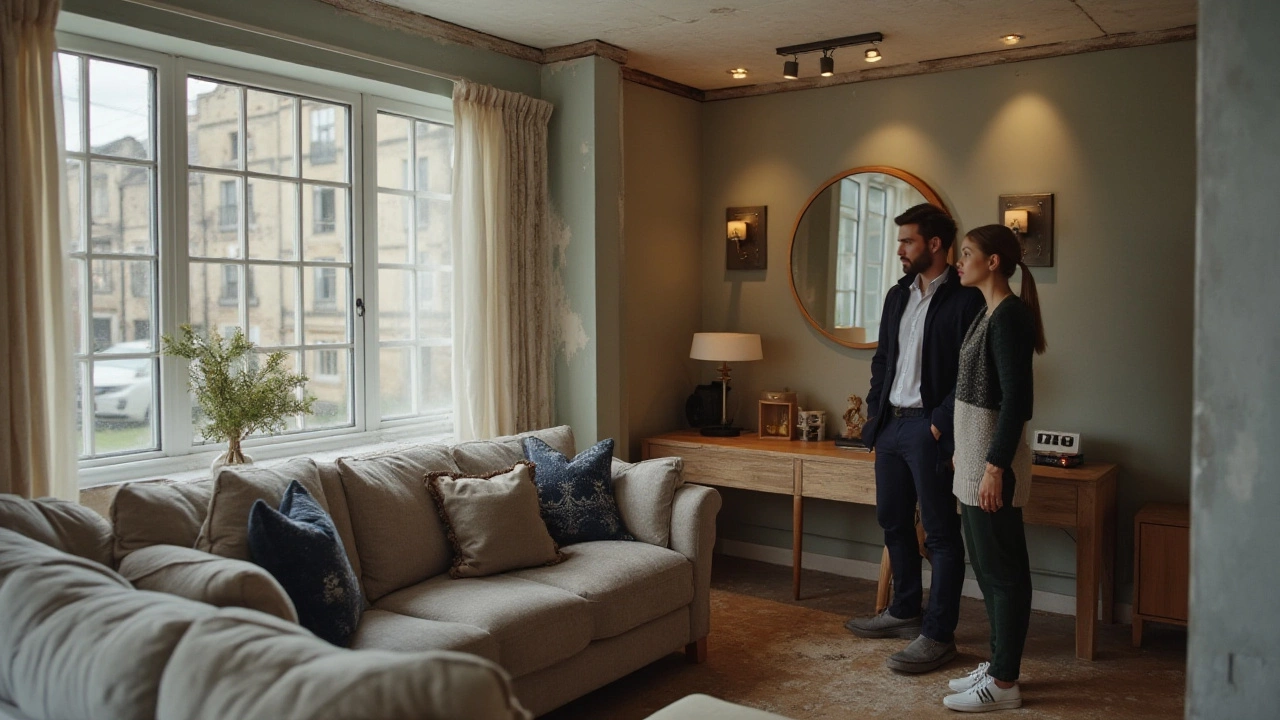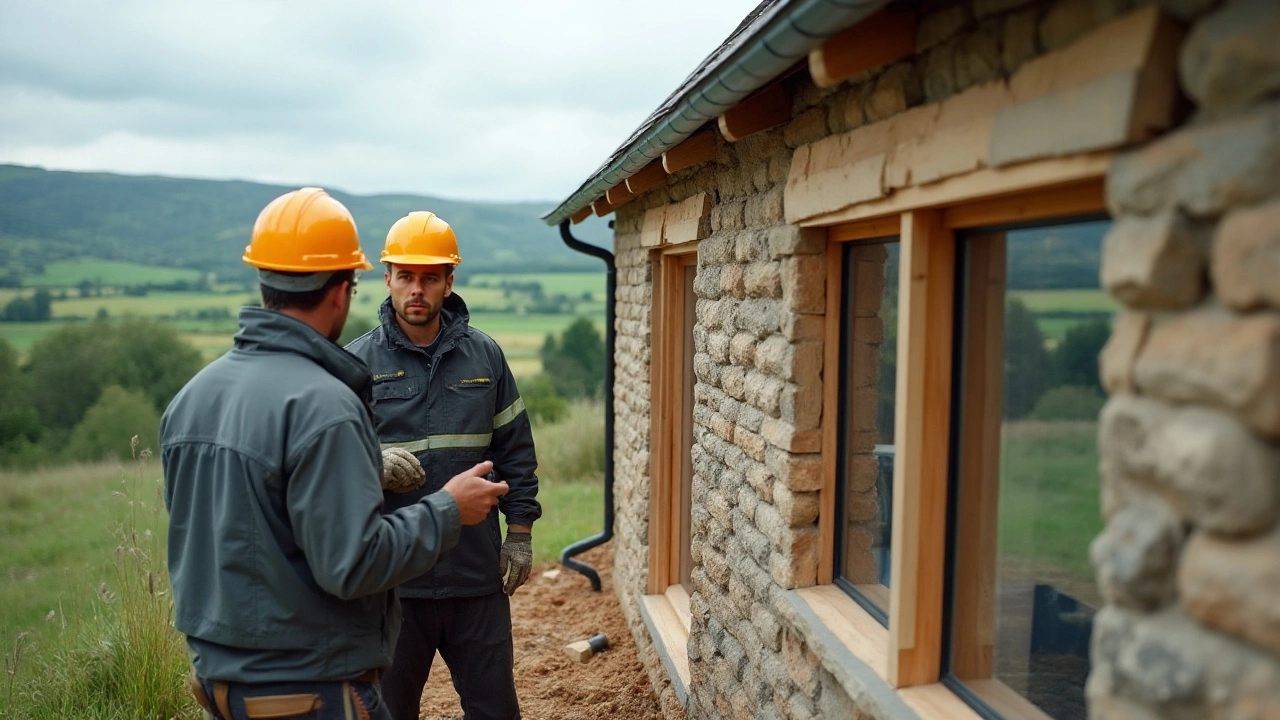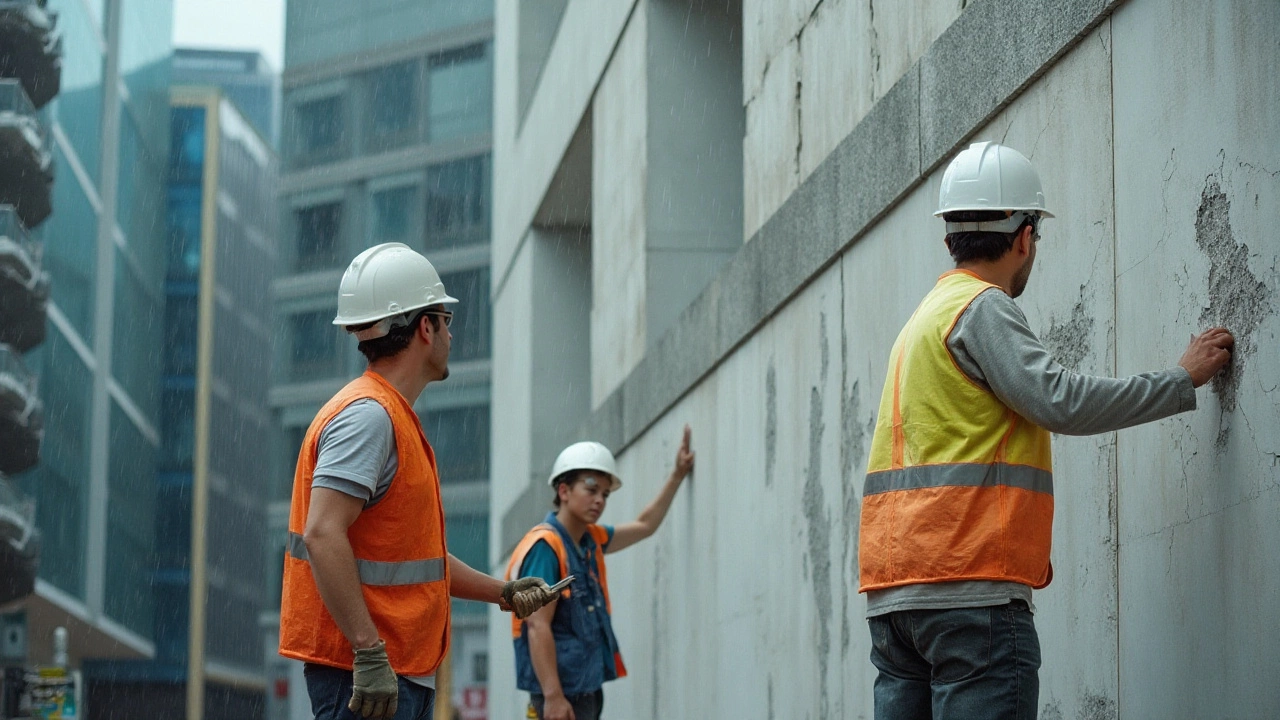When it comes to new builds, the prospect of owning something brand new holds immense appeal. Yet beneath the fresh paint and shiny surfaces can lie a series of hidden pitfalls. Recognizing the most common defects in new constructions can not only save you money but also protect your investment in the long run.
Whether it's a slightly skewed wall or something more serious like water infiltration, being mindful of some typical issues can make a world of difference. With new construction often moving at breakneck speeds to meet market demands, some details might be overlooked, be it related to structure, insulation, or finishes. Navigating these waters requires a sharp eye and a little know-how.
It's not just about finding fault; it's about understanding where and why these problems occur and how best to address or prevent them. As we delve into these common building woes, look out for practical tips and advice on how to tackle these issues head-on or perhaps even avoid them altogether when planning or purchasing your dream home.
- Structural Weaknesses
- Water and Moisture Issues
- Insulation and Energy Efficiency
- Finishing and Aesthetic Flaws
- Inspection and Prevention Tips
Structural Weaknesses
Delving into the realm of structural issues in new buildings can be quite revealing. These defects often originate from miscalculations during the design phase or shortcuts taken during the construction process. A common manifestation is cracking in walls and foundations, which can have serious implications if not addressed promptly. Cracks can allow moisture penetration, leading to a cascade of other problems, like mold and further deterioration of structural integrity. Sometimes, the root cause is as simple as a poorly mixed concrete batch or improper curing, resulting in weakened support. In essence, the marriage of time constraints with human error often births structural troubles.
It's essential to recognize that even seasoned builders can occasionally overlook some of the finer details that contribute to long-lasting construction. Take, for example, the misalignment of beams that, although not immediately visible, can lead to sagging floors over time. Sometimes, defects aren't visible at all until stress is applied in unexpected ways, such as during natural calamities. This calls for thorough inspections post-construction, ideally carried out by independent evaluators. According to the UK’s National House Building Council, conducting a structured audit focusing on load-bearing elements can significantly reduce the incidence of structural failures within the first ten years of a building’s life.
"Building with quality materials and having a robust inspection regime can dramatically reduce inherent structural risks," suggests George Clark, a renowned architect known for his work on sustainable housing projects.
Preventative Measures
Ensuring the structural soundness of a building isn't just the responsibility of engineers and builders; it extends to property owners and future inhabitants as well. Among the most effective strategies is regular maintenance checks, ideally every year, to ensure that unanticipated loads or environmental conditions haven't compromised the building's integrity. Simple practices, like keeping official building plans and regularly comparing them to onsite conditions, can highlight discrepancies quickly.
Moreover, investing in high-quality materials is a preventive measure that pays off in the long run. Using cutting-edge materials resistant to weathering and load variations can vastly improve a building's structural stability. There's also a growing trend in using digital modeling to simulate stress tests on designs before they transition into actual structures, which minimizes unforeseen weaknesses post-construction. Builders are advised to stay up-to-date with advancements in construction material science to align with best practices. In summary, while the art of building involves a harmonious confluence of various elements, the science behind ensuring a robust structure relies heavily on precision, diligent oversight, and the timeless commitment to durability and safety. In the table below, see an overview of common structural defects and their primary causes.
| Defect Type | Primary Cause |
|---|---|
| Wall Cracks | Poor-quality materials, insufficient curing |
| Foundation Shifts | Improper soil analysis, lack of reinforcements |
| Beam Misalignment | Error in load calculations, improper installation |
Water and Moisture Issues
Water and moisture issues are among the top culprits of building defects in new constructions. These problems sneak up quietly, often remaining undetected until they cause significant damage. The primary sources of moisture intrusion include poor waterproofing, defective plumbing, and inadequate ventilation. Understanding how moisture interacts with building materials is crucial for preventing such issues. Improperly installed roofs and poorly placed drainage systems can lead to pooling water, which eventually seeps into the building fabric. Once inside, moisture can weaken structures, promote mold growth, and compromise the integrity of materials, leading to a substantial decrease in property value.
Moisture control should be an integral part of the construction process. Builders need to ensure that all waterproofing membranes are correctly applied, especially in areas prone to water exposure, such as bathrooms, kitchens, and basements. Properly sealed windows and doors are also essential in preventing water ingress. Ventilation plays a critical role in maintaining the right indoor humidity levels. Without adequate airflow, moisture can become trapped, creating an ideal environment for mold and mildew, which are not just unsightly but also pose health risks.
One interesting fact is that water damage is responsible for over half of all insurance claims related to new homes. This statistic highlights the importance of addressing moisture issues proactively. In the words of construction expert Tom Silva,
"Water is the enemy of every building. Protecting your home from it is the best insurance policy you can have."
His statement resonates with many, underscoring the significance of diligent inspections and maintenance. Builders and homeowners should be aware of the signs of water issues, such as discolored walls, a musty smell, or warped flooring. Utilizing moisture-resistant materials and finishes can also add an extra layer of defense. A regular maintenance schedule is essential, checking for leaks or blockages in gutters, downspouts, and drainage channels. These simple yet effective measures can prevent minor issues from escalating into costly repairs.

Insulation and Energy Efficiency
In our journey through the realm of new constructions, one cannot overlook the significance of insulation and energy efficiency as critical factors that contribute to a building's performance and comfort. Insulation, at its core, acts as a barrier to heat flow and is paramount in keeping a property warm in winter and cool in summer. Proper insulation not only enhances living comfort but also significantly reduces energy bills, a benefit for both the pocket and the planet. When insulation is inadequate or poorly installed, it can lead to heat losses in winter and heat gains during summer, compromising both the thermal comfort of the occupants and their utility costs. A well-insulated home utilizes less energy, thereby reducing the demand on heating and cooling systems and decreasing greenhouse gas emissions.
Now, let's delve into specific materials and their properties which are commonly used in new constructions. Traditional options like fiberglass and cellulose have been mainstays, appreciated for their cost-effectiveness and efficiency. Fiberglass, often seen in batts or loose-fill, works by trapping pockets of air, slowing the spread of heat. On the other hand, cellulose, made from recycled paper products, not only insulates well but is also an eco-friendly choice. Meanwhile, modern solutions such as spray foam offer superior air sealing capabilities, helping prevent drafts and moisture from infiltrating the home. In this context, it's crucial to understand that different types of insulation cater to varying needs. Choosing the right type can drastically improve the energy efficiency of a property and ensure it meets modern sustainability standards.
Insulation Standards and Ratings
Insulation is rated by its resistance to heat flow, expressed in terms of R-values—the higher the R-value, the greater the insulating power. Builders often need to adhere to minimum R-values as specified by local building codes, which vary depending on the climate zone. Properties located in colder areas require higher R-values as compared to those in milder climates. According to a recent study, homes that replaced outdated insulation with high R-value materials saw an average of 30% in energy savings annually. However, achieving an optimal R-value isn’t just about the insulation material. Proper installation is key, as even the most efficient materials can underperform if gaps or compression are present.
It's fascinating to note how energy efficiency improvements align with advancements in technology, leading to the development of systems that integrate with smart home solutions. For instance, programmable thermostats, when used in conjunction with well-insulated homes, allow homeowners to save on energy costs by adjusting temperatures based on occupancy and time of day. Albert Einstein once insightfully noted, "We cannot solve our problems with the same thinking we used when we created them," reflecting how innovation in building design and insulation focuses on sustainable and energy-efficient methods that were not prioritized in the past, thus setting new standards for future builds.
Lastly, let's consider the broader impact: effective insulation goes beyond personal comfort and cost savings. It plays a vital role in environmental stewardship, reducing carbon footprints, and promoting a healthier ecosystem. As more countries enforce stricter energy codes and regulations, the push for better insulation and sustainable building practices becomes vital. These changes demonstrate a collective stride towards combating climate change, highlighting insulation not just as a practical home improvement step, but as a symbol of progressive and responsible living.
Finishing and Aesthetic Flaws
In the world of new constructions, finishing and aesthetic flaws often pose significant challenges. Imagine stepping into your newly constructed home only to notice that the paint on the wall seems uneven or that the tiles in the kitchen don’t quite align. These seemingly minor details can affect the perceived quality of the build and, ultimately, your satisfaction. Such flaws can result from a lack of attention to detail, unskilled labor, or even rushed deadlines where the priority is to complete the project as quickly as possible. Understanding these potential pitfalls can help property buyers and builders ensure higher quality standards.
Finishing flaws can manifest in several ways, including poorly installed or finished woodwork, such as crowns and baseboards, which may not fit seamlessly together. Structural issues can also manifest in less obvious ways, like improperly aligned doors and windows that don't open or close smoothly, resulting in draftiness in the cooler months. Aesthetic flaws aren't just a result of flaws in technique; they can stem from improper materials being used to cut costs. For example, using cheap paint can lead to quicker fading or peeling, while sub-par flooring might show wear and tear much sooner.
These defects aren't simply a blemish on the appearance of a home; they often carry implications for property flaws that can reduce energy efficiency or even indicate deeper structural issues, such as improper settling of foundations. As such, a homebuyer should thoroughly inspect the finishing quality of a new build, ideally with a professional who can point out defects and areas of concern. It isn't unheard of for a lack of attention to finishing details to result in legal disputes over hidden construction faults.
"Most property buyers miss these finishing issues during the first inspection, only to realize their significance week into occupancy," according to James Cooke, a seasoned architect from the Royal Institute of British Architects.
Another crucial point to consider is the lighting of the property at various times of day, as certain defects only appear under specific lighting conditions. For a more objective assessment, it’s advisable to visit the property both during the day and at night. These thorough assessments will help uncover any hidden flaws. This also extends to exterior paintwork and landscaping, which should form a harmonious part of the property’s aesthetic appeal.
For those contemplating purchasing new constructions, it's vital to include building defects like these in any snagging list, which is typically drawn up at the end of a project to identify all minor issues needing correction. The existence of a comprehensive snagging list ensures that builders address each necessary repair, aligning the outcome with the initial design plans, and preventing potential disparities between the buyer's expectations and the builder's deliveries. Such lists have saved numerous buyers from persistent headaches associated with persistent minor defects.

Inspection and Prevention Tips
When it comes to safeguarding your investment in a brand-new property, knowing what to look for during the inspection process is crucial. Thoroughly examining a new build isn't just about ticking off a checklist; it's about understanding where potential building defects could crop up and how best to prevent them. Begin by conducting a walk-through of the property with a reputable inspector who is well-versed in new constructions. They should focus on structural aspects, plumbing, electrical systems, insulation, and any signs of premature wear. Often, it is those small imperfections that speak volumes about the quality of workmanship and materials used. Listening attentively to your inspector's observations can offer insights beyond the ordinary, shedding light on seemingly minor defects that could evolve into costly repairs over time.
While the inspector plays a crucial role, homebuyers themselves should also partake in this examination. Strike while the iron is hot, and visit the site at different times of the day to observe how natural light interacts with the interiors. This might reveal issues with the windows or the quality of insulation, which are pivotal for energy efficiency. Testing every light switch and outlet may seem excessive, but it's vital. This process not only ensures everything is in working order but also that the promised electrical setup matches what is actually installed. Unlock and lock every door and window, ensuring they open and close smoothly, as misalignments here could imply structural shifts or improper installations. The devil, as they say, is often in the details.
Proactive prevention is just as important as post-construction inspection. Hiring a builder known for their integrity and quality is worth its weight in gold. Don't shy away from asking for references or visiting previous projects. The quality of past work is a strong indicator of what to expect. It's also wise to demand quality materials explicitly as part of your contract terms, ensuring they meet industry standards. To foster transparency, insist on a clear timeline with regular updates from the construction team, which helps in recognizing early signs of trouble. Quality assurance processes throughout the build can be a game changer in identifying defects before they manifest.
An interesting statistic to consider is that nearly 25% of new homes in the UK experience some form of moisture issue within the first year, suggesting that attention to such detail from the outset can greatly diminish future complications. Moreover, according to a study by the Federation of Master Builders, properties that undergo comprehensive inspections before closing are 40% less likely to require major repairs within the first five years. This emphasizes the value of due diligence in the initial stages.
"Trust is earned, and checking the details is a sign of due diligence, not doubt," says Mark Reynolds, a renowned property consultant. His words hold true for many homebuyers who may feel overwhelmed by the process but should take heart in knowing that meticulousness now could save significant heartache later.Engaging in an informed, meticulous inspection process – keeping an eye out for those telltale signs of major structural issues, water leakage, and poor finishing – allows homeowners to nip in the bud what could potentially burgeon into a costly ordeal. Being prepared and informed turns the seemingly daunting task of inspection into a manageable and rewarding step in owning a new home.
